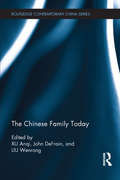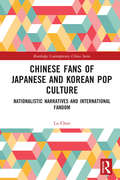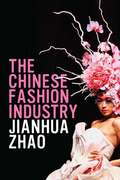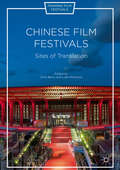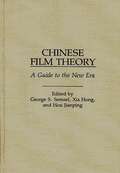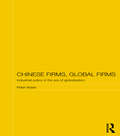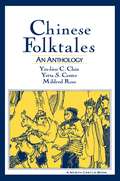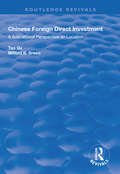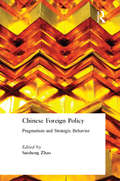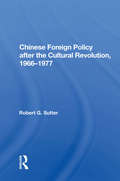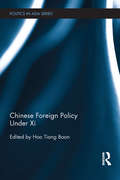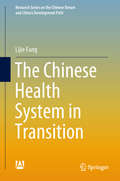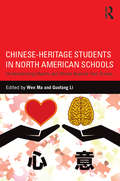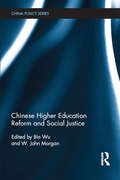- Table View
- List View
The Chinese Family Today (Routledge Contemporary China Series)
by XU Anqi, John DeFrain, and LIU WenrongThe Chinese economy is undergoing dramatic changes and the world is watching and changing along with it. The Chinese family is also changing in many ways in response to the economic transformation that is moving the world’s most populous nation from an agrarian economy to a global superpower. This is the first book in English to describe and explain the social transformation of the Chinese family from the perspective of Chinese researchers. Presenting a comprehensive view of the Chinese family today and how it has adapted during the process of modernization, it provides description and analysis of the trajectory of changes in family structures, functions, and relationships. It tracks how Chinese marriages and families are becoming more diverse and face a great deal of uncertainty as they evolve in different ways from Western marriages and families. The book is also unique in its use of national statistics and data from large-scale surveys to systematically illustrate these radical and extraordinary changes in family structure and dynamics over the past 30 years. Demonstrating that the de-institutionalization of family values is a slow process in the Chinese context, this book will be of interest to students and scholars of Chinese Studies, Sociology, Social Policy and Family Policy.
Chinese Fans of Japanese and Korean Pop Culture: Nationalistic Narratives and International Fandom (Routledge Contemporary China Series)
by Lu ChenHow can Japanese popular culture gain numerous fans in China, despite pervasive anti-Japanese sentiment? How is it that there’s such a strong anti-Korean sentiment in Chinese online fan communities when the official Sino-Korean relationship is quite stable before 2016? Avid fans in China are raising hundreds of thousands of dollars in funding to make gifts to their idols in foreign countries. Tabloid reports on Japanese and Korean celebrities have been known to trigger nationalist protests in China. So, what is the relationship between Chinese fandom of Japanese and Korean popular culture and nationalist sentiment among Chinese youth? Chen discusses how Chinese fans of Japanese and Korean popular culture have formed their own nationalistic discourse since the 1990s. She argues that, as nationalism is constructed from various entangled ideologies, narratives, myths and collective memories, popular culture simply becomes another resource for the construction of nationalism. Fans thus actively select, interpret and reproduce the content of cultural products to suit their own ends. Unlike existing works, which focus on the content of transnational cultural flows in East Asia, this book focuses on the reception and interpretation of the Chinese audience.
Chinese Fans of Japanese and Korean Pop Culture: Nationalistic Narratives and International Fandom (Routledge Contemporary China Series)
by Lu ChenHow can Japanese popular culture gain numerous fans in China, despite pervasive anti-Japanese sentiment? How is it that there’s such a strong anti-Korean sentiment in Chinese online fan communities when the official Sino-Korean relationship is quite stable before 2016? Avid fans in China are raising hundreds of thousands of dollars in funding to make gifts to their idols in foreign countries. Tabloid reports on Japanese and Korean celebrities have been known to trigger nationalist protests in China. So, what is the relationship between Chinese fandom of Japanese and Korean popular culture and nationalist sentiment among Chinese youth? Chen discusses how Chinese fans of Japanese and Korean popular culture have formed their own nationalistic discourse since the 1990s. She argues that, as nationalism is constructed from various entangled ideologies, narratives, myths and collective memories, popular culture simply becomes another resource for the construction of nationalism. Fans thus actively select, interpret and reproduce the content of cultural products to suit their own ends. Unlike existing works, which focus on the content of transnational cultural flows in East Asia, this book focuses on the reception and interpretation of the Chinese audience.
The Chinese Fashion Industry: An Ethnographic Approach (Dress, Body, Culture)
by Jianhua ZhaoLess than three decades ago, when the Chinese bought cloth or clothes, they would have had to use a government-issued coupon. Today the Chinese fashion industry is one of the most dynamic in the world - it not only supplies fashions to the increasingly discerning domestic market, but also provides one-third of the clothing sold in the global market. How did this phenomenal transition come about? What can the growth of the Chinese fashion industry tell us about the post-Mao China? What roles do the local and the global play in the dramatic changes? This book offers a historically informed, ethnographically grounded and interpretive analysis of contemporary Chinese fashion and the fashion industry. It examines the interplay of state politics, market forces, local social and cultural factors, and the global political economy, both in the rise of the Chinese fashion industry and in the life and work of Chinese fashion professionals. As the first ethnographic account of the Chinese fashion industry in the post-Mao era, The Chinese Fashion Industry combines first-hand accounts with sophisticated cultural analysis to offer new insights, and will be of interest to students and scholars of fashion, anthropology and China.
The Chinese Fashion Industry: An Ethnographic Approach (Dress, Body, Culture)
by Jianhua ZhaoLess than three decades ago, when the Chinese bought cloth or clothes, they would have had to use a government-issued coupon. Today the Chinese fashion industry is one of the most dynamic in the world - it not only supplies fashions to the increasingly discerning domestic market, but also provides one-third of the clothing sold in the global market. How did this phenomenal transition come about? What can the growth of the Chinese fashion industry tell us about the post-Mao China? What roles do the local and the global play in the dramatic changes? This book offers a historically informed, ethnographically grounded and interpretive analysis of contemporary Chinese fashion and the fashion industry. It examines the interplay of state politics, market forces, local social and cultural factors, and the global political economy, both in the rise of the Chinese fashion industry and in the life and work of Chinese fashion professionals. As the first ethnographic account of the Chinese fashion industry in the post-Mao era, The Chinese Fashion Industry combines first-hand accounts with sophisticated cultural analysis to offer new insights, and will be of interest to students and scholars of fashion, anthropology and China.
Chinese Film Festivals: Sites of Translation (Framing Film Festivals)
by Chris Berry Luke RobinsonThis book is the first anthology of research devoted to the booming world of Chinese film festivals, covering both mainstream and independent films. It also explores festivals in the Chinese-speaking world and festivals of Chinese films in the rest of the world. The book asks how Chinese film festivals function as sites of translation, translating Chinese culture to the world and world culture to Chinese-speaking audiences, and also how the international film festival model is being transformed as it is translated into the Chinese-speaking world.
Chinese Film in the Twenty-First Century: Movements, Genres, Intermedia (Communicating China)
by Cecília Mello Corey SchultzThis book examines Chinese film in the twenty-first century. Organized around the themes "movements," "genres," and "intermedia," it reflects on how Chinese cinema has changed, adapted, and evolved over past decades and prognosticates as to its future trajectories. It considers how established film genres in China have adapted and transformed themselves, and discusses current shifts in documentary filmmaking, the ethos and practices of "grassroots intellectual" independent filmmakers, and the adaption of foreign film genres to serve the ideological and political needs of the present. It also explores how film is drawing on the socio-historical and political contexts of the past to create new cinematic discourses and the ways film is providing a voice to previously marginalised ethnic groups. In addition, the book analyses the influences of past aesthetic traditions on the creative and artistic expressions of twenty-first-century films and cinema’s relation to other media forms, including folktales, moving image installations, architecture, and painting. Throughout, the book assesses how Chinese films have been conceptualized, examined, and communicated domestically and abroad and emphasizes the importance of new directions in Chinese film, thus highlighting the plurality, vitality, and hybridity of Chinese cinema in the twenty-first century.Chapter 10 of this book is freely available as a downloadable Open Access PDF at http://www.taylorfrancis.com under a Creative Commons Attribution-Non Commercial-No Derivatives (CC-BY-NC-ND) 4.0 license.
Chinese Film in the Twenty-First Century: Movements, Genres, Intermedia (Communicating China)
This book examines Chinese film in the twenty-first century. Organized around the themes "movements," "genres," and "intermedia," it reflects on how Chinese cinema has changed, adapted, and evolved over past decades and prognosticates as to its future trajectories. It considers how established film genres in China have adapted and transformed themselves, and discusses current shifts in documentary filmmaking, the ethos and practices of "grassroots intellectual" independent filmmakers, and the adaption of foreign film genres to serve the ideological and political needs of the present. It also explores how film is drawing on the socio-historical and political contexts of the past to create new cinematic discourses and the ways film is providing a voice to previously marginalised ethnic groups. In addition, the book analyses the influences of past aesthetic traditions on the creative and artistic expressions of twenty-first-century films and cinema’s relation to other media forms, including folktales, moving image installations, architecture, and painting. Throughout, the book assesses how Chinese films have been conceptualized, examined, and communicated domestically and abroad and emphasizes the importance of new directions in Chinese film, thus highlighting the plurality, vitality, and hybridity of Chinese cinema in the twenty-first century.Chapter 10 of this book is freely available as a downloadable Open Access PDF at http://www.taylorfrancis.com under a Creative Commons Attribution-Non Commercial-No Derivatives (CC-BY-NC-ND) 4.0 license.
Chinese Film Theory: A Guide to the New Era
by Xia Hong Hou Jianping George S. SemselThis is the first collection of translations of Chinese film theory to be published in English. By using translations rather than summaries, as other works have done, Chinese Film Theory provides readers with an introduction to the issues current in China's film circles. It includes eighteen chapters written by a broad range of writers--from well established scholars to young people at the beginning of their involvement in film in China. This collection indicates a trend away from the study of external qualities of film and toward a study of the film itself.The volume has been carefully organized so that major issues are interrelated; thus, the book comprises an ongoing debate of film theory issues, progressing from earlier to most recent issues, following the debate concerning the relationship of film to literary arts, and looking at the debate over the relationship of film to culture. The book concludes that for the time being, debate has virtually ended because of the political situation in China. This book is an important new source to anyone interested in film studies, film theory, or Chinese studies.
Chinese Firms, Global Firms: Industrial Policy in the Age of Globalization (Routledge Studies on the Chinese Economy)
by Peter NolanChina has achieved remarkable, sustained economic growth under the policies of ‘reform and opening up’ put into place since the late 1970s. China’s industrial policies have nurtured a large group of firms with high profits and a high market capitalisation. However, few people in the West can name a single Chinese firm. During the modern era of capitalist globalisation firms from the high income countries have spread their business systems across the world. This has presented a profound challenge for industrial policy in developing countries, including even China, the world’s second largest economy. China is unique among large latecomer developing countries in having reached the position of being a huge, fast-growing economy, with a tremendous impact on the rest of the world, but lacking a substantial group of globally competitive firms. This volume explores this paradox. Fully understanding the industrial policy challenge that the era of capitalist globalisation has produced for China is essential for harmonious international relations.
Chinese Firms, Global Firms: Industrial Policy in the Age of Globalization (Routledge Studies on the Chinese Economy)
by Peter NolanChina has achieved remarkable, sustained economic growth under the policies of ‘reform and opening up’ put into place since the late 1970s. China’s industrial policies have nurtured a large group of firms with high profits and a high market capitalisation. However, few people in the West can name a single Chinese firm. During the modern era of capitalist globalisation firms from the high income countries have spread their business systems across the world. This has presented a profound challenge for industrial policy in developing countries, including even China, the world’s second largest economy. China is unique among large latecomer developing countries in having reached the position of being a huge, fast-growing economy, with a tremendous impact on the rest of the world, but lacking a substantial group of globally competitive firms. This volume explores this paradox. Fully understanding the industrial policy challenge that the era of capitalist globalisation has produced for China is essential for harmonious international relations.
Chinese Folktales: An Anthology
by Yin-Lien C. Chin Yetta S. Center Mildred Ross"Flows with the naturalness of conversation". -- The Small Press Book Review"Translated with simplicity and lucidity". -- The Book Reader"This collection of twelve traditional tales from various parts of China in different time periods represents a popular choice and one sure to be well-received". -- Religious Studies Review
Chinese Folktales: An Anthology
by Yin-Lien C. Chin Yetta S. Center Mildred Ross"Flows with the naturalness of conversation". -- The Small Press Book Review"Translated with simplicity and lucidity". -- The Book Reader"This collection of twelve traditional tales from various parts of China in different time periods represents a popular choice and one sure to be well-received". -- Religious Studies Review
Chinese Foreign Direct Investment: A Subnational Perspective on Location (Routledge Revivals)
by Tao Qu Milford B. GreenFirst published in 1997, this volume emerged in the wake of China’s Open Door policy. Qu and Green focus on the spatial aspects of foreign direct investment within China. They aim to locate FDI within a subnational context, with particular reference to the Chinese experience between 1979 and 1993. Issues explored include the philosophy, objectives and process of inducing FDI, the choice of cities and the country of origin effect. Issues explored include the philosophy, objectives and process of inducing FDI, the choice of cities and the country of origin effect.
Chinese Foreign Direct Investment: A Subnational Perspective on Location (Routledge Revivals)
by Tao Qu Milford B. GreenFirst published in 1997, this volume emerged in the wake of China’s Open Door policy. Qu and Green focus on the spatial aspects of foreign direct investment within China. They aim to locate FDI within a subnational context, with particular reference to the Chinese experience between 1979 and 1993. Issues explored include the philosophy, objectives and process of inducing FDI, the choice of cities and the country of origin effect. Issues explored include the philosophy, objectives and process of inducing FDI, the choice of cities and the country of origin effect.
Chinese Foreign Policy: Pragmatism and Strategic Behavior
by Suisheng ZhaoThis volume explores how China is adapting to international norms and practices while still giving primacy to its national interests. It examines China's strategic behaviour on the world stage, particularly in its relationships with major powers and Asian neighbours.
Chinese Foreign Policy: Pragmatism and Strategic Behavior
by Suisheng ZhaoThis volume explores how China is adapting to international norms and practices while still giving primacy to its national interests. It examines China's strategic behaviour on the world stage, particularly in its relationships with major powers and Asian neighbours.
Chinese Foreign Policy/h
by Robert G. SutterChinese foreign policy has changed radically since the Cultural Revolution of 1966-1969. This book focuses on turning points in China's policy and looks at the influence of foreign pressures on China. It assesses the impact of internal political struggles on the conduct of Chinese foreign affairs.
Chinese Foreign Policy/h
by Robert G. SutterChinese foreign policy has changed radically since the Cultural Revolution of 1966-1969. This book focuses on turning points in China's policy and looks at the influence of foreign pressures on China. It assesses the impact of internal political struggles on the conduct of Chinese foreign affairs.
Chinese Foreign Policy Under Xi (Politics in Asia)
by Hoo Tiang BoonThere has been a discernable calibration of Chinese foreign policy since the ascension of Xi Jinping to the top leadership positions in China. The operative term here is adjustment rather than renovation because there has not been a fundamental transformation of Chinese foreign policy or "setting up of a new kitchen" in foreign affairs. Several continuities in Chinese diplomacy are still evident. The People’s Republic of China (PRC) has not wavered from its overarching strategy of rising through peaceful development. The PRC is still an active participant and leader in, or shaper of, global and regional regimes even as it continues to push for reforms of the extant order, towards an arrangement which it thinks will be less unjust and more equitable. It seeks to better "link up with the international track", perhaps even more so under Xi’s stewardship. Yet amidst these continuities, it is clear that there have been some profound shifts in China’s foreign policy. From the enunciation of strategic slogans such as the "Asian security concept" and "major country diplomacy with Chinese characteristics"; the creation of the China-led and initiated Asian Infrastructure Investment Bank; the pursuit of Xi’s signature foreign policy initiative, the One Belt One Road; to a purportedly more assertive and resolute defense of China’s maritime territorial interests in East Asia—examples of these foreign policy calibrations (both patent and subtle) abound. In short, this has not been a complete metamorphosis but there are real changes, with important repercussions for China and the international system. The burning questions then are What, Where, How and Why: What are these key foreign policy adjustments? Where and how have these occurred in Chinese diplomacy? And what are the reasons or drivers that inform these changes? This book seeks to capture these changes. Featuring contributions from academics, think-tank intellectuals and policy practitioners, all engaged in the compelling business of China-watching, the book aims to shed more light on the calibrations that have animated China’s diplomacy under Xi, a leader who by most accounts is considered the most powerful Chinese numero uno since Deng Xiaoping.
Chinese Foreign Policy Under Xi (Politics in Asia)
by Tiang Boon HooThere has been a discernable calibration of Chinese foreign policy since the ascension of Xi Jinping to the top leadership positions in China. The operative term here is adjustment rather than renovation because there has not been a fundamental transformation of Chinese foreign policy or "setting up of a new kitchen" in foreign affairs. Several continuities in Chinese diplomacy are still evident. The People’s Republic of China (PRC) has not wavered from its overarching strategy of rising through peaceful development. The PRC is still an active participant and leader in, or shaper of, global and regional regimes even as it continues to push for reforms of the extant order, towards an arrangement which it thinks will be less unjust and more equitable. It seeks to better "link up with the international track", perhaps even more so under Xi’s stewardship. Yet amidst these continuities, it is clear that there have been some profound shifts in China’s foreign policy. From the enunciation of strategic slogans such as the "Asian security concept" and "major country diplomacy with Chinese characteristics"; the creation of the China-led and initiated Asian Infrastructure Investment Bank; the pursuit of Xi’s signature foreign policy initiative, the One Belt One Road; to a purportedly more assertive and resolute defense of China’s maritime territorial interests in East Asia—examples of these foreign policy calibrations (both patent and subtle) abound. In short, this has not been a complete metamorphosis but there are real changes, with important repercussions for China and the international system. The burning questions then are What, Where, How and Why: What are these key foreign policy adjustments? Where and how have these occurred in Chinese diplomacy? And what are the reasons or drivers that inform these changes? This book seeks to capture these changes. Featuring contributions from academics, think-tank intellectuals and policy practitioners, all engaged in the compelling business of China-watching, the book aims to shed more light on the calibrations that have animated China’s diplomacy under Xi, a leader who by most accounts is considered the most powerful Chinese numero uno since Deng Xiaoping.
The Chinese Health System in Transition (Research Series on the Chinese Dream and China’s Development Path)
by Lijie FangThis book provides an overview of the ongoing transition in China’s health system, especially focusing on the new healthcare reform initiated in 2009. First, it reviews the changes in China’s healthcare system from the 1950s to 2008, establishing the situation when the reform was introduced. The book subsequently analyzes the social and economic context in which the health system is embedded. Since the primary focus is on the new healthcare reform, the book introduces the blueprint and the year-for-year development of the new healthcare reform, as well as the specific reforms in health financing, public hospitals, and primary care. Given its central importance in the health system, the book also described major trends in long-term care in the past several years. In addition, it examines the health policy-making process with a case study of the New Cooperative Medical Scheme of China. Lastly, the book assesses the performance of China’s health system and predicts future developmental trends.
Chinese-Heritage Students in North American Schools: Understanding Hearts and Minds Beyond Test Scores
by Wen Ma Guofang LiThis comprehensive look at Chinese-heritage students’ academic, sociocultural, and emotional development in the public schools examines pertinent educational theories; complex (even inconvenient) realities; learning practices in and outside of schools; and social, cultural, and linguistic complications in their academic lives across diverse settings, homes, and communities. Chinese-heritage students are by far the largest ethnic group among Asian American and Asian Canadian communities, but it is difficult to sort out their academic performance because NAEP and most state/province databases lump all Asian students’ results together. To better understand why Chinese-heritage learners range from academic role models to problematic students in need of help, it is important to understand their hearts and minds beyond test scores. This book is distinctive in building this understanding by addressing the range of issues related to Chinese-heritage K-12 students’ languages, cultures, identities, academic achievements, and challenges across North American schools.
Chinese-Heritage Students in North American Schools: Understanding Hearts and Minds Beyond Test Scores
by Wen Ma Guofang LiThis comprehensive look at Chinese-heritage students’ academic, sociocultural, and emotional development in the public schools examines pertinent educational theories; complex (even inconvenient) realities; learning practices in and outside of schools; and social, cultural, and linguistic complications in their academic lives across diverse settings, homes, and communities. Chinese-heritage students are by far the largest ethnic group among Asian American and Asian Canadian communities, but it is difficult to sort out their academic performance because NAEP and most state/province databases lump all Asian students’ results together. To better understand why Chinese-heritage learners range from academic role models to problematic students in need of help, it is important to understand their hearts and minds beyond test scores. This book is distinctive in building this understanding by addressing the range of issues related to Chinese-heritage K-12 students’ languages, cultures, identities, academic achievements, and challenges across North American schools.
Chinese Higher Education Reform and Social Justice (China Policy Series)
by John Morgan Bin WuIn place of a distributive justice perspective which focuses simply on equal access to universities, this book presents a broader understanding of the relationship between Chinese higher education and economic and social change. The necessity for research on the place of universities in contemporary Chinese society may be seen from current debates about and policy towards issues of educational inequality at Chinese universities. Many questions arise as a consequence: What are the limitations of neo-liberalism in higher education policy and what are the alternatives? How has the Chinese government met the challenges of educational inequality, and what lessons may be learned from its recent initiatives? How may higher education enhance social justice in Chinese society given economic, social, and cultural inequality? What may be learned from the experience of Macau, Hong Kong, and of Taiwan in terms of achieving social justice in Chinese universities? These questions are considered by a group of leading scholars from both inside and outside China.
